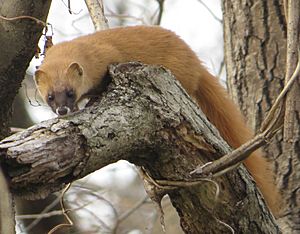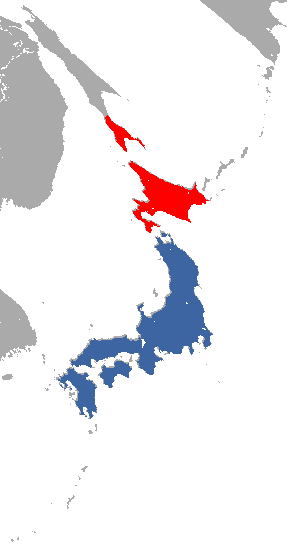Japanese weasel facts for kids
Quick facts for kids Japanese weasel |
|
|---|---|
 |
|
| Conservation status | |
| Scientific classification | |
| Genus: |
Mustela
|
| Species: |
itatsi
|
 |
|
| Japanese weasel range (blue - native, red - introduced) |
|
The Japanese weasel (Mustela itatsi) is a small, meat-eating mammal. It belongs to the weasel family, called Mustelidae. These quick animals live in Japan, especially on the islands of Honshu, Shikoku, and Kyushu. While they can be found in flat areas, in western Japan they prefer mountains.
Contents
What Does the Japanese Weasel Look Like?
Japanese weasels are quite small. Adult males can grow to about 35 centimetres (14 inches) long, not counting their tail. Their tails can add another 17 centimetres (6.7 inches) to their length. Female weasels are usually smaller than the males. Their fur is a pretty orange-brown color, often with darker spots or markings.
Where Do Japanese Weasels Live?
Japanese weasels first lived on three of Japan's main islands: Honshu, Kyushu, and Shikoku. But over the last 100 years, people have moved them to many other Japanese islands. This was done to help control the number of rodents. Now, you can find them on Hokkaido and many of the Ryukyu Islands.
These weasels live in many different ecosystems across Japan. They often live in mountains and forests, especially near rivers or streams. They do most of their hunting along these waterways. Sometimes, they might even go into grasslands or areas near towns.
In winter, when there's snow, these slim weasels spend a lot of time under it. They chase small rodents through tunnels they find in the snow. After catching and eating their prey, they often enjoy the warmth of the prey's nest.
What Do Japanese Weasels Eat?
Japanese weasels are not picky eaters! They hunt and eat many different things. Their diet includes mice, frogs, reptiles, insects, and crayfish. Sometimes, if they are very hungry, they will also eat berries, seeds, and fruits.
Male weasels tend to eat more mammals and crustaceans. Female weasels often prefer insects, fruits, and earthworms.
What they eat can change with the season and how much food is available. Fish and insects are a regular part of their diet all year. For example, they eat mostly beetles in spring and fruits in summer. In autumn, they like grasshoppers and crustaceans, while in winter they eat fish and fruit. Japanese weasels are helpful because they keep the populations of rodents and other small animals in check.
How Do Japanese Weasels Behave?
Japanese weasels usually live alone. The only times they are together are when they mate or when a mother is raising her young. They don't like other weasels coming into their home area and will protect it. If a weasel feels scared, it can release a strong smell, called musk, to scare away predators.
These weasels are also amazing hunters. They will chase their prey in any way they can. This includes running through tunnels, climbing trees, or even swimming. If prey can go somewhere, a weasel can usually follow! They hunt both during the day (diurnal) and at night (nocturnal).
Japanese Weasel Life Cycle
The mating season for Japanese weasels is from early May to late June. After mating, the mother weasel carries her babies for about 30 days. This is called gestation. A mother can have anywhere from 2 to 12 babies, but usually, she has 5 or 6. The young weasels are ready to be weaned and live on their own after about 8 weeks. Japanese weasels can start having their own babies when they are about one year old.
In Kyushu, weasels can have babies twice a year. In Hokkaido, they usually have babies once a year.
Why Are Japanese Weasels Important?
In the past 100 years, Japanese weasels have been brought to many smaller Japanese islands. This was done to help get rid of rats that were harming crops. Along with special rat poisons, the weasels helped lower the number of rats. Japanese weasels are also sometimes caught for their fur, which is used in the fur trade. However, weasels can sometimes hunt farm birds like chickens and ducks.
Are Japanese Weasels in Danger?
The number of Japanese weasels is slowly going down. However, they are still listed as "Least Concern" on the IUCN Red List. This means they are not in immediate danger because they live in many places across Japan. The biggest problem for Japanese weasels is losing their habitat. This happens when land is used for homes and businesses.
Images for kids
See also
 In Spanish: Comadreja japonesa para niños
In Spanish: Comadreja japonesa para niños




